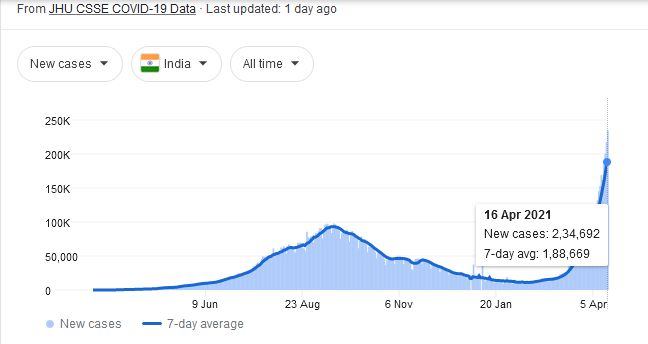Disclaimer: This article is only meant to stimulate discussion amongst professional homeopaths. It does not encourage people to take any homeopathic remedy without professional consultation. If you have symptoms similar to Covid-19, get yourself tested and consult your GP or homeopath.
.
The first wave of Covid-19 peaked in India in September 2020, with nearly 100,000 new cases every day. Then it started declining and came down to a level of around 12,000 cases per day by January 2021. This was a small number for a country with the size and population of India. Large parts seemed covid free and we were hoping to finally be free from this pandemic.
In March 2020, I published my initial assessment of Covid 19 symptoms with indicated homeopathic remedies. I argued that Bryonia seems to be a very close match. I updated that article till September 2020 with many updates, research data, and clinical experience. Bryonia alba did prove to be the most useful remedy last year with excellent reports from the world over and even an ICMR controlled trial showing a 75% efficacy.
Then in March 2021, a fresh wave of Covid-19 began with a few different strains of the virus. It has spread like a wildfire. We are already touching a quarter-million cases a day and experiencing partial lockdowns.

The current wave is still building up but I would like to share my assessment and experience early on, with the hope that it will prove useful to the community.
This Covid-19 Wave is different.
During last year, the most common symptoms were :
- Fever, which was not too high, and often lasted for 2-4 days in most cases. Only in few cases, it was protracted.
- Dry mouth, with increased thirst.
- Bodyache
- Loss of taste and smell
- Dry cough
The current wave of Covid-19 seems different with the following symptoms:
- Fever, which is usually high, often protracted, and with chills
- Dry mouth but less thirst
- Headache (more common than the last wave)
- Conjunctivitis
- Irritation in the throat. It feels more like a sore throat.
- Productive cough
- Hearing issues like tinnitus and hearing loss
Many other symptoms fluctuate in frequency and intensity. These include
- diarrhoea and cramps
- discolouration of toes and fingers
- dizziness
- nausea and vomiting
- Aphthae etc.
On repertorising these symptoms and based on early clinical experience, I believe the remedies that will prove most useful for the current wave are –
Belladonna, Hepar sulphuris, Gelsemium.
I believe Belladonna or Gelsemium will help in most cases with high fever and early symptoms. I am seeing many cases where Gelsemium is helping. Hepar sulph will help (if the symptoms match of course) when the productive cough sets in.
Let us look at when and how to prescribe these remedies, with a few other remedies to consider.
Belladonna
- The suddenness is one of the main characteristics of Belladonna. Everything comes in paroxysms with suddenness and goes with equal suddenness. But while it lasts, there seems to be a very intense and life-threatening situation.
- Decreased mucus production in the nose and throat; consequent dry, sore throat, dry mouth.
- Stopping of sweating; consequent decreased epidermal thermal dissipation leading to warm, blotchy, or red skin.
- Increased body temperature
- Pupil dilation; consequent sensitivity to bright light (photophobia)
- Increased heart rate
- Tendency to be easily startled
- In Belladonna headaches, there is intense heat of the head with redness of the face.
- Belladonna fevers are sudden, high grade, inflammatory and intermittent associated with heat of head and coldness of extremities or heat of head and coldness of back. There is heat and marked redness of the face, dryness of skin, dryness of the mouth with thirstlessness.
- headache and pains are often throbbing and shooting in nature.
- Desire for lemon or lemonade.
- Discharges of Belladonna are usually hot like urine, menstrual discharge etc.
- Worse- from all stimuli like light, noise, jar, motion etc.
Hepar sulphuris
- Sensation of a plug or a fishbone or a splinter or rawness in throat. Stitches in throat extending to ear when swallowing; on turning the head. Hawking up of mucus. Pressive and constrictive sensation in throat.
- Cough: dry, hoarse cough; excited whenever any part of the body gets cold or uncovered, or from eating (or drinking) anything cold; crying, talking, walking. Croup and loose, choking; barking, < cold drinks or in morning; hacking as from a feather.
- Expectoration: Weakness and much rattling in the chest; can’t expectorate; tightens up in cold air; thick, yellow.
- Sensitivity, pain, redness and tickling in larynx indicate Hepar.
- Mentally Hep. patients are difficult and have a critical and discontented look.
- Later stages of pneumonia, where dyspnoea is more pronounced, may need Antim-tart or Carbo-veg.
- Aggravation: Cold air; open air. Undressing; uncovering. Touching the parts. Lying on the painful side; night.
Amelioration: From warmth. Covering. Damp wet weather
Aconite
- Aconite cures cases that have a sudden onset, acute congestive in type, with high fever, high arterial tension, burning thirst, dry skin, fear and restlessness. The cough is dry and painful. The keynotes are:
- Anxious look. (Expressions), Fear and restlessness. (Ars.), Sudden onset. (Bell.) Attacks following chilling from cold, dry winds or during cold spells of weather or after sweating.
Both Aconite and Belladonna have a sudden onset and high fever. To differentiate, remember Aconite has more anxiety, restlessness, and thirst as compared to Belladonna.
Gelsemium
- Gelsemium has marked dullness, drowsiness, prostration, and thirstlessness.
- Desire to be quiet, to be let alone, does not wish to speak, nor have anyone near her for company, even if the person be silent (Ignatia).
- Fear of death (Arsenicum), utter lack of courage. Weakness and trembling, of tongue, hands, legs, of the entire body.
- Headache: beginning in the cervical spine, pains extend over the head, causing a bursting sensation in the forehead and eyeballs (Sanguinaria, Silicea, begin in the same way, but are semi – lateral)
- Great heaviness of the eyelids, cannot keep them open (Causticum, Graphites, Sepia).
- Chill: Without thirst. Chill commences in the hands and feet (in recent cases – in old chronic cases, Nat. ). Chill ascending from feet, chill and chilliness, especially along the spine, running up the back from loins to the nape of the neck, and following each other in rapid wave-like succession from sacrum to occiput (running up and down the spine, Eup-purp. ). Chilliness with cold hands and feet, headache, and heat of head and face. Chilliness with tired, languid feeling in back and limbs, wants to avoid all muscular exertion.
- Heat: Without thirst, intense burning. General heat, mostly about the head and face. Warmth over the whole body, as if sweat would break out, then chilly down the back.
- Sweat coming gradually and moderately, always ameliorated the pains. The patient is nervous, irritable, easily angered.
Other homeopathic remedies to consider
Bryonia, Arsenic album
Bryonia has a gradual onset, dryness of mucous membranes with increased thirst. Dry or productive cough with stitching pains. Aggravation from motion.
Arsenic album has low thirst, is anxious and restless, with weakness out of proportion to the presenting symptoms.
Please read the details of these and many other remedies in my previous analysis.
For fever associated with diarrhea/vomiting/nausea – Nux vomica, Baptisia, Lachesis, Ocimum sanctum, Acid phosphoricum, Camphora, and Arsenicum album.
Recommended dosage: 30C or 200C potency, every two hours initially. Then reduce repetition as the symptoms abate. Potency and dose selection is usually done according to the severity of symptoms and vitality of the patient. There is no ideal dose for everyone.
Please remember: Homeopathy is strictly based on symptom similarity. A remedy will only work if it matches the symptoms of the patient closely. That remedy can be Belladonna, Bryonia, Arsenic alb, Aconite, Hepar sulph, Baptisia or something else. Please evaluate the totality of the case before prescribing any remedy.
Note: This is just an early sharing of thoughts and experiences. I invite you to send me your feedback and your own clinical experiences so that we can update these recommendations as our collective experience increases. You can write to me at [email protected]
Additions – 20/4/2021
- Have added Gelsemium to the original list as seeing many cases needing Gels. Have received many reports about the use of Gelsemium this season.
- Richard Pitcairn says Nux vomica is more commonly indicated in USA
- Another reader mentioned that Mercurius solubilis is often indicated in Europe.
Don’t follow any recommendations blindly. Please match the symptoms of your patients to the remedy.


